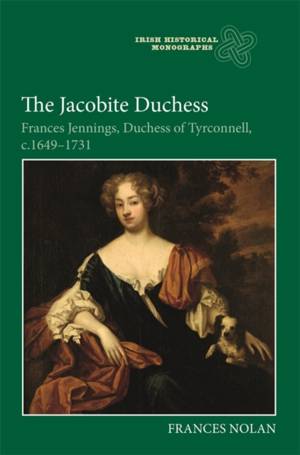
Je cadeautjes zeker op tijd in huis hebben voor de feestdagen? Kom langs in onze winkels en vind het perfecte geschenk!
- Afhalen na 1 uur in een winkel met voorraad
- Gratis thuislevering in België vanaf € 30
- Ruim aanbod met 7 miljoen producten
Je cadeautjes zeker op tijd in huis hebben voor de feestdagen? Kom langs in onze winkels en vind het perfecte geschenk!
- Afhalen na 1 uur in een winkel met voorraad
- Gratis thuislevering in België vanaf € 30
- Ruim aanbod met 7 miljoen producten
Zoeken
€ 120,95
+ 241 punten
Omschrijving
Frances Jennings, elder sister of Sarah, duchess of Marlborough, had an interesting and eventful life, most notably as the influential wife of Richard Talbot, earl of Tyrconnell, Catholic viceroy of Ireland under James II. Born circa 1649 into a Hertfordshire gentry family, she was a noted beauty at the Restoration court. There, she met and married George Hamilton, a Catholic officer who, after 1667, served in Louis XIV's army. In Paris, Frances raised three daughters, converted to Catholicism, and became an active member of the English Catholic émigré community. Following Hamilton's death, she remarried to Richard Talbot. As vicereine of Ireland, Frances helped re-establish Catholic hegemony, assisting in the foundation of convents and re-consecration of Christ Church cathedral. During the Williamite-Jacobite War in Ireland (1689-91), Frances fled to James II's exiled court in France. In 1691, she received word that her husband, now Jacobite duke of Tyrconnell, had died. Attainted for high treason, she used the Marlboroughs' influence to recover her Irish estates. In 1708, she returned to Dublin, where she died in 1731. Highlighting Frances's political manoeuvrings, religious identity and deep family attachments, this book portrays a complex and contested figure, a woman who acted on multiple stages, in diverse roles, challenging expectations of rank, gender, and 'nationality' in unexpected ways.
Specificaties
Betrokkenen
- Auteur(s):
- Uitgeverij:
Inhoud
- Aantal bladzijden:
- 276
- Taal:
- Engels
- Reeks:
- Reeksnummer:
- nr. 23
Eigenschappen
- Productcode (EAN):
- 9781783276141
- Verschijningsdatum:
- 17/09/2021
- Uitvoering:
- Hardcover
- Formaat:
- Genaaid
- Afmetingen:
- 156 mm x 234 mm
- Gewicht:
- 562 g

Alleen bij Standaard Boekhandel
+ 241 punten op je klantenkaart van Standaard Boekhandel
Beoordelingen
We publiceren alleen reviews die voldoen aan de voorwaarden voor reviews. Bekijk onze voorwaarden voor reviews.









